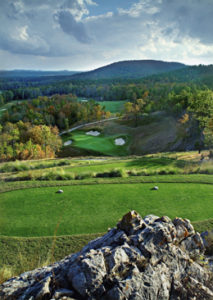ASGCA members Michael Hurdzan, Dana Fry, and David Whelchel, all of Hurdzan Golf, helped the Pursell Family build FarmLinks Golf Course in Sylacauga, Alabama. As a research and demonstration facility, the course integrates many ecosystems to provide a wide range of observations on the impacts of design, construction, and maintenance inputs.

Hole 5, FarmLinks Golf Course, Sylacauga, Alabama
The Pursell Family’s fertilizer company had pioneered work on encapsulating fertilizer and chemicals in polymers that release their materials at precisely the rate that plants can use them. This approach reduces, or even eliminates, the leaching of necessary maintenance materials into groundwater; sharply curtails excessive or unneeded applications; and saves fossil fuel and manpower by reducing the frequency of applications.
The family decided to develop a golf course where their products could be showcased and their story told. Several other manufacturers were recruited to participate in the concept, making the course a living laboratory and test ground.
After the developer and architects made a collective decision to integrate as many ecosystems and ecotones as practical, such areas were mapped and reviewed for a constraints and opportunities map. Using this map, the challenge then became to route the golf holes. The companies permitted the holes to flow harmoniously one to the next, but also minimally disturbed each environment, keeping them isolated and functioning as they had before the golf course was built. In addition, the architects made diligent efforts to protect adjacent non-disturbed areas of the property.
FarmLinks Golf Course has been fully operational since 2003 and has hosted thousands of superintendents, students, educators, and researchers for demonstrations of its on-going projects. As an outreach education/research facility, the organization consistently works to reduce the input amount of water, fertilizer, pesticide, and fossil fuel on its course. FarmLinks is a continual work in progress, providing lessons that can give way to far-reaching impacts.
To read more Environmental Case Studies, please visit here.
